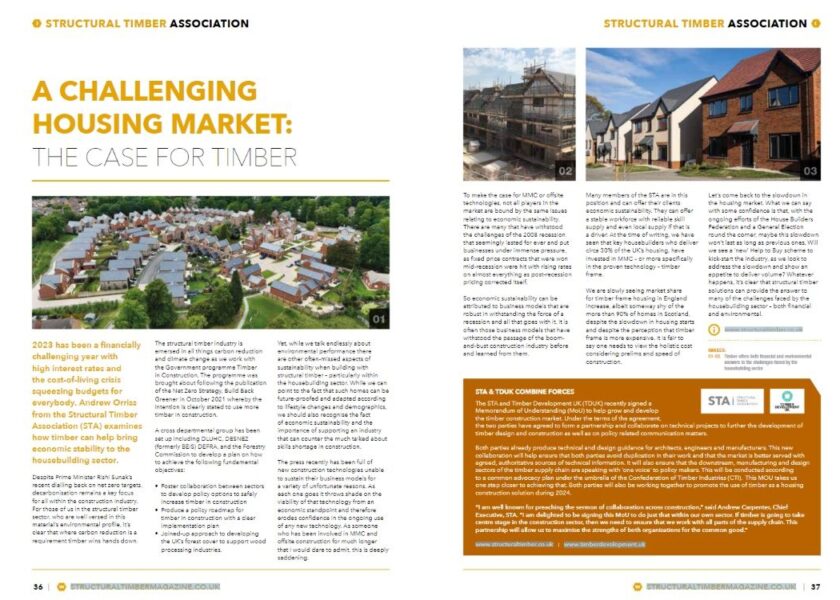A challenging housing market: the case for timber
27/11/2023

There’s no doubt that 2023 has been a financially challenging year for many, with high interest rates and the cost-of-living crisis continuing to squeeze budgets for households and businesses alike. Here, Andrew Orriss of the Structural Timber Association, examines the case for timber when it comes to bringing economic stability to the housebuilding sector.
Despite Prime Minister Rishi Sunak’s recent dialling back on Net Zero targets, decarbonisation remains a key focus for all within the construction industry. For those of us in the structural timber sector, who are well versed in this material’s environmental profile, it’s clear that where carbon reduction is a requirement timber wins hands down.
The structural timber industry is emersed in all things carbon reduction and climate change as we work with the Government programme Timber in Construction. The programme was brought about following the publication of the Net Zero Strategy, Build Back Greener October 2021 whereby the intention is clearly stated to use more timber in construction.
A cross departmental group has been set up including DLUHC, DESNEZ (Formerly BEIS) DEFRA, and the Forestry Commission to develop a plan on how to achieve the following fundamental objectives:
- Foster collaboration between sectors to develop policy options to safely increase timber in construction.
- Produce a policy roadmap for timber in construction with a clear implementation plan.
- Joined-up approach to developing the UK’s forest cover to support wood processing industries.
Yet, while we talk endlessly about environmental performance there are other often-missed aspects of sustainability when building with structural timber – particularly within the housebuilding sector. So, while we can point to the fact that such homes can be future-proofed and adapted according to lifestyle changes and demographics, we should also recognise the fact of economic sustainability and the importance of supporting an industry that can counter the much talked about skills shortage in construction.
The press recently has been full of new construction technologies unable to sustain their business models for a variety of unfortunate reasons. As each one goes it throws shade on the viability of that technology from an economic standpoint and therefore erodes confidence in the ongoing use of any new technology. As someone who has been involved in MMC and Offsite construction for much longer that I would dare to admit, this is deeply saddening.
To make the case for MMC or Offsite technologies, not all players in the market are bound by the same issues relating to economic sustainability. There are many that have withstood the challenges of the 2008 recession that seemingly lasted for ever and put businesses under immense pressure, as fixed price contracts that were won mid recession were hit with rising rates on almost everything as post-recession pricing corrected itself.
So economic sustainability can be attributed to business models that are robust in withstanding the force of a recession and all that goes with it. It is often those business models that have withstood the passage of the boom-and-bust construction industry before and learned from them.
Many members of the Structural Timber Association are in this position and can offer their clients economic sustainability. They can offer a stable workforce with reliable skill supply and even local supply if that is a driver. At the time of writing, we have seen that key housebuilders who deliver circa 30% of the UK’s housing, have invested in MMC – or more specifically in the proven technology that is, timber frame.
We are slowly seeing market share for timber frame in housing in England increase, albeit someway shy of the more than 90% of homes in Scotland, despite the slowdown in housing starts and despite the perception that timber frame is more expensive. Fair to say one needs to view the holistic cost considering prelims and speed of construction.
Let’s come back to the slowing in the housing market. What we can say with some confidence is that, with the ongoing efforts of the House Builders Federation and an election round the corner, maybe this slow down won’t last as long as previous ones. Will we see a ‘new’ Help to Buy scheme to kick-start the industry as we look to address the slowdown and show an appetite to deliver volume? Whatever happens, it’s clear that structural timber solutions can provide the answer to many of the challenges faced by the house building sector – both financial and environmental.
To read the feature click here